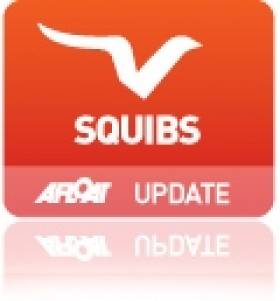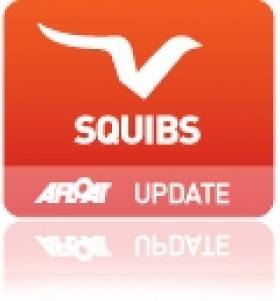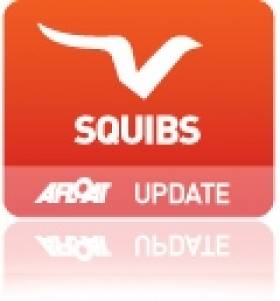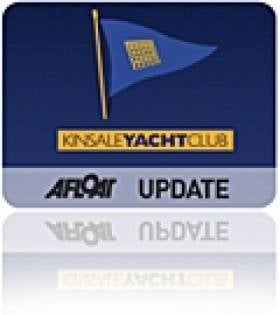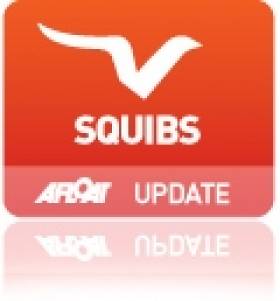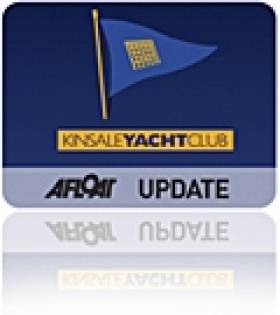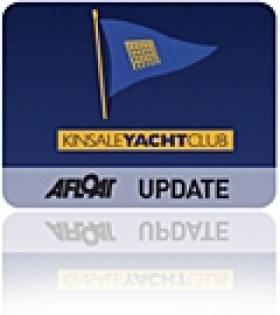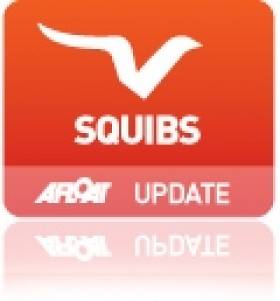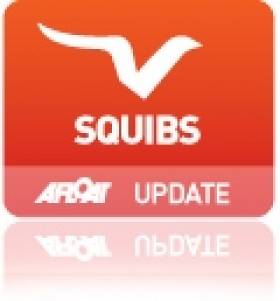Displaying items by tag: squib
#squib – In August, the Squib Class will be returning to the southern shores of Belfast Lough and the Royal North of Ireland Yacht Club.
The Rodgers & Browne Squib Irish Championship, supported by North Down Borough Council, will be held over the 9th- 11th August and will attract Squibs from throughout Ireland to compete for the national trophy.
The Squib Class is one of the largest one design keelboat classes in Ireland. It is sailed by two people and is well known for its distinctive brown sails. Over the last decade fleets have flourished at Killyleagh Yacht Club, Quoile Yacht Club, Royal St George Yacht Club (Dublin) and Kinsale Yacht Club, in addition to the traditional strongholds of Cultra and Howth Yacht Club.
The reigning champion pairing of James and Bruce Matthews from Kinsale Yacht Club will battle with past winners and recently crowned Eastern Champions, John Driscoll/David Cagney, and Northern Champions, David Eccles/Michael Wright, all of whom are in contention for the main prize.
Thomas Anderson, Commodore of the Royal North commented "I am delighted to welcome the Squib Irish Championship back to Cultra. This has only been possible with the ongoing support of Rodgers & Browne and North Down Borough Council. The Squib Class has been the backbone of our Club for several decades and it is fantastic that the fleet will be showcased through this event. In addition to the excellent sailing waters of Belfast
Lough, the Club's well known hospitality will ensure that this event will be well worth attending".
Connor Browne, Partner at Rodgers & Browne, said "We are looking forward to collaborating again with the Royal North of Ireland Yacht Club and the Squib Class to bring the Irish Championship to Cultra. North Down is a stunning location for many sporting activities, which is reflected in the demand for housing within the greater Holywood, Helen's Bay and North Down areas."
#squib – 25 Squibs keelboats will compete for the first time for Southern Championship honours on July 19 at Glandore in West Cork. Ten visitors are expected to join a local fleet of 15 according to Glandore Harbour Yacht Club Commodore John Dowling.
#squib – The key to a successful cruise is good organisation. Plan ahead, select your destination, ensure that the tide is going in a favourable direction, ensure that the facilities at your place of arrival are adequate for your group of cruisers, and that the weather is fine writes Vincent Delany.
A Squib class event was conceived on 12th June after club racing, to cruise on the following Saturday to Howth, on the opposite side of Dublin Bay, on the expectation of a fish and chip lunch at Beshoff's famous fish shop, followed by a leisurely pint at Howth Yacht Club.
All did not go to plan.
There was a high pressure system sitting over the east coast of Ireland on Saturday morning with about 1 knot of wind from the north. It took the seven squibs, (Jill, Conor and Dermot in Perfection, Vincent and Joe in Femme Fatale, Gerry and Elena in Buzz Lite, Sheila and Gilly in Little Demon, Rupert and Emily in Sidewinder, Fergal and Wendy in Aija and Derek and Jean in Why Not) at least an hour to sail from the Royal St George Yacht Club to the Dun Laoghaire Harbour mouth. At that rate of progress they were guaranteed not to have a favourable tide all the way to Howth Harbour. What should they do? It was agreed to raft up and put the thinking hats on! Then a small breeze from the north east appeared. Somebody suggested "Let's go to Clontarf.", the Squibs were pointed in the direction of Poolbeg where two venerable lighthouses mark the entrance to Dublin Port. En route we sailed through hundreds of large racing yachts looking for wind, and when they found it, trying to get it to stay in a constant direction to allow a Bloomsday race to start.
When the first Squibs reached Poolbeg lighthouses, they waited for the others to catch up, before entering the Dublin Port area where Clontarf is on the north shore. The tide was almost full in so there was plenty of depth, except in a few areas which were inevitably unmarked. As the Clontarf fleet were our racing, some moorings were lifted and some anchors dropped in the shallow water. Yes we did know that the moorings dry out at low water. Next question was, how do we get ashore? A launch appeared from nowhere, welcomed us to Clontarf, an asked us where we had come from, and enquired if we wanted to go ashore. Some headed straight to Beshoffs (yes there are two branches of Beshoffs, on in Howth and one in Clontarf.) while others went straight to the Yacht club for refreshment. Peter Reilly asked us if we would like to see the O'Brien Kennedy designed IDRA 14 footer which is currently being built at the back of the clubhouse by the members. She was progressing well with at least half the planking complete. When we came back to the front of the clubhouse the 15 hungry Squibs we consuming huge platters of sandwiches which had been quickly made by Mrs. O'Rourke. It turned out that Clontarf is celebrating the 100 year centenary of another invasion, from the Vikings, so the Squibs were invited to don some Viking helmets.
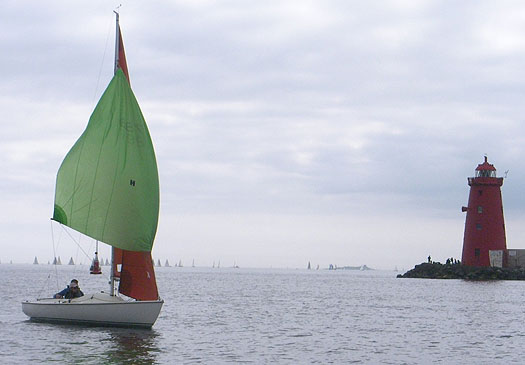
The Squibs make their way into Dublin Port
After about an hour of chat and gossip, it was time to check our boats in the falling tide. Yes they were all afloat with at least 300mm of water under the keels. An informal race was made out of the return trip, during which some Squibs were nearly run down by freighters entering Dublin Port. The light wind was from the south east, which meant that it was a beat all the way, but with a strong tide under us.
When only a few hundred yards from Dun Laoghaire harbour mouth, the wind disappeared entirely, so it was time to apply some paddle power.
In retrospect, spontaneity can be great fun. We should all spend more time cruising! .
#squib – A strong Royal North of Ireland contingent took the top three places overall at yesterday's 23–boat Squib keelboat eastern championships at the Royal St. George Yacht Club in Dun Laoghaire. Full results are available to download below. Overall winners were 1996 Olympic helmsman John Driscoll sailing with David Cagney on 6 nett points. Second on ten points was Royal North club mates Gordon Patterson and Ross Nolan with third going to Des Clayton and Paul Henry on 20 points. Local Royal St. George crew Pete Evans and Paul Maguire were next home on 22 points.
As well as Royal North of Ireland visitors came from Killyleagh, Royal Irish Yacht Club, and National Yacht Club.
The first three races were held in approx. 15kts. of cold northerly wind with a big confused sea left over from gales of the previous night.
Race 1 was won by Martin Byrne and Joe O'Byrne in 24, Femme Fatale from Pete Evans and Paul Maguire in 832, Anemos and Peter and Marie Dee in 813 Kookaburra. Remarkably each of these Dublin Bay boats is manned by refugees from the Dragon fleet.
Race 2 was won by Olympian John Driscoll and Dave Cagney in 78, Afficianado from Gordon Patterson and Ross Nolan in Quickstep III with Des Clayton and Paul Henry in 794, Inismara. This result with three northern boats is a carbon copy of the final overall placings.
With crews getting tired in the strenuous conditions, Race 3 was won by Quickstep III followed by Afficianado and Anemos
Overnight the leaders were Quickstep III from Femme Fatale and Inismara on equal points. The Royal St. George put on an enjoyable dinner for all the competitors and their friends and partners.
Sunday dawned with very different conditions, sunshine, fickle winds of between 3-6 knots which progressively swung around from the west to the north. Fortunately the waves had declined from the previous day, so the conditions were more kindly to the lighter crews.
Race 4 was won by light air specialist Frank Whelan 46, in Lola from Afficianado and Kookaburra. After 4 races a discard was applied which was beneficial to Afficianado who had missed the first race (for reasons best known to themselves), and Anemos who were able to drop their OCS.
The final race in a falling wind went to Afficianado from best lady Jill Fleming and Conor O'Leary in 44, Perfection and Quickstep III.
In the final line up it was three Royal North of Ireland boats in the top 3 places.
The fleet will compete again next week in The Northern Championships in Killyleagh.
Kinsale Yacht Club Launches One Design Keelboat Regatta
#kinsale – The May bank holiday event saw the inaugural 'Axiom sponsored One Design keelboat Regatta' held in Kinsale YC. Twelve Squibs and five Dragons came out to do battle for the very generous prizes and newly commissioned trophy.
PRO Tony Ireson and his team provided great racing with 6 races held over the two days on a windward leeward course. Saturdays racing was held in 12-18 knots from the south west with the opening races in Dragons been taken by Little fella sailed by Cameron Good/Simon Furney and Henry Kingston.
The Squibs were having a fierce battle with places at the top constantly been swapped with National Champion James Mathews in Mucky Duck, Colm Dunne and Rob Gill in Allegro and Finbarr and Cian O'Regan in Fagin. Kevin Downey knocked in a great day with 4, 4, 5 in his new squib Grey Matter.
Day two saw the wind blowing from due south so Tony Ireson set his line at the mouth of the harbour. Lumpy seas and slightly lighter winds made for difficult sailing but Colm Dunne and Cameron Good found the groove and extended their leads with both finishing as overall winners.
At the prize giving there was great excitement as to which boat would win the newly commissioned trophy and after the criteria was spelt out by sailing secretary John Stallard the first name to go on the trophy is Allegro sailed by Colm Dunne and Rob Gill.
Such was the success of the event club Commodore Finbarr O' Regan was able to announce that Axiom Private Clients are to come on board for 2015 as the main sponsor and the dates were announced as May 2nd &3rd 2015.
#squib – The Royal St George Yacht Club hosts the Irish Squib East Coast Championship 2014 from 24-25 May 2014 writes Squib captain Rupert Bowen.
The Dun Laoghaire class welcomes Squib sailors back to the club, which hosted the Irish Squib Nationals in 2012 with 32 entries and the UK Squib Nationals in 2010 with over 70 entries. 15-20 entries for the Easterns this year, although it could be more (32 boats entered the Squib Inlands in Dromineer last October)
The plan is to run five races over the two days and to award prizes after racing concludes on Sunday 25th May.
The Squib is a 6m keelboat that can appeal to a wide range of sailors and levels of experience, age etc. There are active and growing Squib fleets all around Ireland and Great Britain. In the Dublin Bay fleet we have teenagers and retired men and women and all ages in between! We have sailors who have competed at the highest level internationally as well as people who simply enjoy a race "around the cans" in Dublin Bay. We race around the buoys in Dublin Bay on Tuesday, Thursday evenings and around "Olympic" dinghy courses on Saturday afternoons.
Kinsale Yacht Club Frostbite Prizes Awarded But No Last Race
#kinsale – Well it proved to be a Lose Lose day in Kinsale. Ireland lost in Rugby and the KYC Frostbite Series lost to the Gales!
The wind at 11.00 am was recorded at a mere 10 knots so the Committee boat headed out to set a course. However as the windward mark was about to be set some 30 minutes later, the wind reading had increased to 26 knots so racing was abandoned in the interests of safety.
Several Squibs and Lasers had launched so enjoyed a blast around the harbour before heading back to the Clubhouse for the presentation of prizes for the series.
Kinsale Yacht Club Commodore Finny O'Regan gave an opening address thanking Seamus McLaverty of ASM marine for his continuing support as sponsor for the Frostbites.
He also thanked Bruce Matthews for his involvement in and support of the Frostbites going back 25 years.
Thanks were also expressed for all the Club members who helped make the Frostbites possible, from the mark-layers and safety boat personnel to those ashore in particular Caroline Forde who did sterling work on the results and weekly race reports.
June Matthews (pictured below left) presented the prize winners in each class with their trophies.
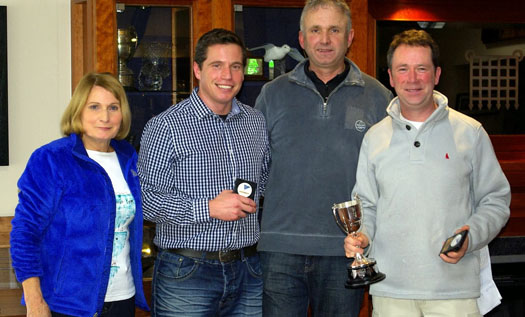
June Matthews, Rob Gill , KYC Commodore Finny O'Regan, Colm Dunne. Rob Gill & Colm Dunne receiving 1st place prize in the Squib Fleet.
The Prize winners were as follows:
Squib Class:
1st Allegro, Colm Dunne & Rob Gill KYC 2nd Lazurus, Colm Daly & Marcus Hutchinson KYC 3rd Fagin, Colm & Finny O'Regan KYC
Laser Full Rig Class:
1st Sean Murphy KYC
2nd James Long, Inniscarra
3rd Ian Travers KYC
Laser 4.7 Rig Class:
1st Billy Duane RCYC
2nd Ben Hunt KYC
3rd Jamie Tingle RCYC
Laser Radial Class:
1st Sorcha Ni Shuilleabhain KYC
2nd Cliodhna O'Regan KYC
3rd Sean Gambier-Ross KYC
Kinsale Lasers & Squibs Enjoy Wild Ride in Frostbite Sailing Series
#kinsalesailing – Wild conditions for the penultimate day's racing have will bring Kinsale Yacht Club's Frostbite Series to a fitting climax next Saturday.
Yestrerday, for the ASM sponsored series, the wind was steady South South West and varied in strength from 14 to 25 knots. The Race Committee reported that competitors were extremely eager on the start line resulting in several individual recalls.
Colm Dunne & Rob Gill (KYC) are runaway leaders in the Squib fleet in Allegro with a current total of a perfect 9 points for 9 races after discards are applied. The next closest Squib is Lazurus with Colm Daly & Marcus Hutchinson (KYC) on a total of 21 points. Finny and Colm O'Regan (KYC) are in third place with 24 points in Fagin. These 3 boats have broken away from the rest of the fleet with a gap of 19 points between the 3rd and 4th boats. The real battle at this stage is for 4th place with Breakaway (Julie Silfverberg & Liz Bond KYC) on 43 points, Espresso ( Ruth Ennis & Victor Fusco KYC) on 44 points and Pulpo ( Tom Roche & Bobby Nash KYC) also on 44 points.
A similar trend has emerged in the Full Laser fleet with KYC Sean Murphy taking a resounding lead on 12 points followed by Inniscarra James Long on 26 points. Ian Travers (KYC) is in third place with 29 points, Monkstown's Paul O'Sullivan is in 4th with 32 points which is some 30 points ahead of the 5th boat.
The Laser Radials competitors stayed at home today and only two 4.7's came to the race area. Despite not racing today, Billy Duane (RCYC) still holds first position on 10 points. Ben Hunt (KYC) is in second position on 17 points followed by Jamie Tingle (RCYC) on 41 points.
The series ends next Saturday with the final 3 races, there will be a prize giving in the Club House afterwards.
Royal Yachting Association (RYA) Cancels Squib Builder's Licence
#squib – The Royal Yachting Association (RYA) has cancelled a licence for the building of the Squib keelboat in the UK, according to a report on its website, leaving the class – that has a strong following in Ireland – without a builder.
The RYA reports that whilst some classes have a number of different builders producing boats, the Squib has been built since 2009 by BP Sailboats based in Essex. Unfortunately, there have been a recent series of events which have led to the RYA having to withdraw the licence issued to BP Sailboats.
Bas Edmonds, RYA Technical and Racing Services Manager explains: "The purpose of the RYA's involvement within classes such as the Squib is to protect its design integrity and to ensure that any developments within the class are controlled and considered before being voted on. However it came to light that BP Sailboats had modified the keel pattern without approval and when the RYA came to arrange an inspection we were informed that the company were no longer trading in the UK. We had no alternative but to initiate a one month cancellation clause within our licence with BP Sailboats which will prohibit BP Sailboats from building Squibs."
"It has come to light that as part closing down the moulds, which we and the NSOA firmly believe belong to the Squib Class, have been moved to an undisclosed location."
This leaves the Squib Class with no licenced builder and no knowledge of the whereabouts of its moulds.
Lough Derg's Irish Squib Inland Championships Attracts Big Turnout
#squib – Lough Derg Yacht Club in Tipperary was busy in 2013. This Club on the River Shannon held the Mirror World Championships in August, and one of the biggest Irish one-design keelboat regattas of 2013 with 80 boats competing, on the weekend of 18th - 20th October, with fleets of Dragons, SB20s and National Squibs as well as handicap racing for a cruiser fleet.
The National Squib fleet had a very strong entry of 29 boats from Cultra on Belfast Lough (4), Dublin Bay (10), Glandore (2), Howth (2), and Kinsale (4), Killilea(1), as well as the home Dromineer fleet (4).
On Saturday, PRO Geoff Donoghue laid a short windward leg, a long spinnaker reach to an outer loop with 2 downwind legs and one upwind leg in Youghal Bay. The wind was shifty and varied from force 1-2 on beautifully flat water. Race 1 went to current National Champion from Kinsale, James Matthews and Rob Jacob in 51, 'Mucky Duck' from Howth's husband/wife team Jonathan and Hazel Craig in 37, 'Kerfuffle' and Gordon Patterson and Ross Nolan in 820 'Quickstep III'.
Race 2 was won by 'Kerfuffle' followed by 'Mucky Duck' and Cian O'Regan in 100, 'Fagan' which really is the quickest boat in the fleet. Race 3 was won by East Coast Champion Fergus O'Kelly in 223, 'Selik' from 'Quickstep III' and Peter and Marie Dee from Royal St. George Y.C. in 813 'Kookaburra'. It was becoming evident at this stage that a good start on the short windward leg was vital to achieving a good finish.
Race 4 was won by 'Kookaburra' from Frank Whelan and Brian Hare in 46, 'Lola'.
Remarkably, a long days racing in shifty winds had produced three different winners.
Dinner for 200 competitors in the Club was followed by craic in the 'Whisky Still' which resulted in some competitors not being fit to sail on Sunday. On Sunday, a stronger wind blew from the south, so a course was laid between Dromineer Bay and The Mountaineer buoy. The squibs sailed a conventional windward leeward course. The race was won by Colm Dunne in the beautifully prepared 134, 'Allegro' from Vincent Delany and Mary Mc.Loughlin in 24, 'Femme Fatale' from son and father team Tim and Derek Jago in 798, 'Why Not'. It is possible that this was the most competitive Squib event in Ireland this year, with all boats discarding high scores. In fact many had two high scoring races which pushed them down the results board. No fleet dominated the event, although the Kinsale fleet seems strongest, while Dun Laoghaire, Howth, Cultra were all achieved top 5 places.
Such a good turn out of boats begs the question....Should the National Championships be held in Dromineer in the Autumn? This is the great unanswered question, but we do know that there will be more than 30 boats competing in this fun filled event next year.
For results see below.


























